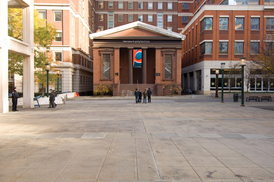Bridge Street AWME Church
It was October 1865, only months after the last shots of the Civil War were fired. People in Brooklyn opened their newspaper, the Brooklyn Eagle, to learn that “Last evening an immense congregation, fully half consisting of whites, was present at the African M. E. Church in Bridge street.” What brought so many white people to the black church? Harriet Tubman, the most famous “conductor” on the Underground Railroad, was speaking. Moses, as she was called, was in a familiar place. Before the Civil War she had led some 300 enslaved men, women, and children to freedom by hiding in “stations” such as the Bridge Street Church during the day and traveling at night.
The original church, known as the Sand Street Methodist Episcopal Church, was founded by a British army captain in 1766. He first led open-air services for a congregation of blacks, whites, and Indians near the banks of the East River. The congregation grew and the church moved indoors. Unfortunately, racism eventually developed, and the African Americans were first segregated and then barred from the altar and charged a fee for worshiping.
The black worshipers broke away in 1816 and organized the African Methodist Episcopal Church on High Street. Later, when it moved, it was called the Bridge Street Church. The congregation could claim many firsts. They had the first black church in Brooklyn. It was located in Weeksville, one of the first black communities in the city. And in 1827, the congregation opened Brooklyn’s first school for black children.
Related Media
Images

|
Today the Bridge Street AWME Church is located at 277 Stuyvesant Avenue, where it continues to attract many new parishioners from Africa and Latin America.
|

|
Runaway slaves were once hidden in the basement of the Bridge Street Church at 311 Bridge Street. Today the site is the Student Center of Polytechnic University.
|
